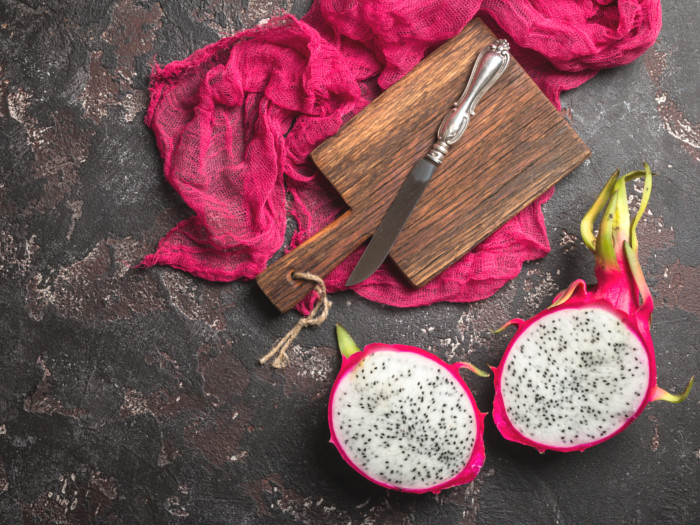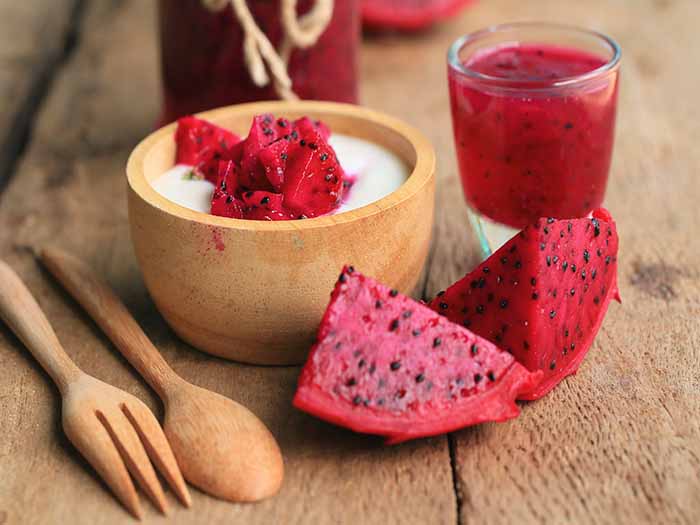If you see a bright pink fruit with wild, scaly skin in your supermarket, it is most likely a dragon fruit. Dragon fruit, also known as pitaya, is a delicious, tropical fruit that is native to Central America. It is now also grown in Southeast Asian countries, such as Thailand and Vietnam and is available in markets worldwide.
Due to its numerous health benefits and attractive appearance, pitaya has garnered a lot of attention in recent times. You can also add this wonderful fruit to your diet and while it may look spiky and tough to handle, it is quite easy to cut.
How to Cut a Dragon Fruit?
Let us look at the steps to cut this tropical fruit:
- Step 1: Cut a fresh dragon fruit into two halves.
- Step 2: Scoop out the flesh from each half with the help of a spoon by running the spoon around the edges. The flesh of a ripe dragon fruit will come out effortlessly. It is quite similar to scooping out the flesh of a ripe avocado.
- Step 3: You can slice or cut the flesh into cubes. You can even use a melon spoon to make your fruit salad look pretty.
Note: The remaining skin or the core of the fruit can be used as a fancy serving bowl.

The best way to eat dragon fruit is by slicing it into two equal halves first. Photo Credit: Shutterstock
Dragon Fruit (Pitaya) Recipes
This antioxidant-rich fruit can be used in preparing many mouth-watering recipes that include salads, smoothies, and kebabs. [1]
Dragon Fruit Smoothie
Ingredients:
½ cup milk
1 teaspoon honey
Chopped dragon fruit
Dry fruits or nuts for garnishing
Ice cubes (optional)
Preparation:
- Step 1: Mix all the ingredients and blend until you get a thick consistency.
- Step 2: Pour the mixture into a glass or a cup. Garnish with finely chopped almonds or dry fruits as per taste.
Note: You can use this smoothie to make a nutritious smoothie bowl.
Dragon Fruit Kebabs
Ingredients
Dragon fruit
Kiwi
Pineapple
Edible Oil
Pepper to taste
Salt to taste
Preparation:
- Step 1: Cut all the fruits into cubes, brush them with oil and put them on a grill plate.
- Step 2: Grill them for 10 minutes.
- Step 3: Sprinkle some salt and pepper powder on the kebabs and serve hot.
Tropical Fruit Salad
Ingredients
Dragon fruit
Strawberries
Bananas
Apples
Papaya
Honey or Chocolate syrup
Preparation:
- Step 1: Cut all the fruits into small pieces and mix them in a bowl.
- Step 2: Refrigerate them for few minutes.
- Step 3: Garnish with honey or chocolate syrup, and enjoy your healthy dessert!
Dragon Fruit Taste
The taste of fresh dragon fruit (pitaya) is somewhat bland. It is usually mildly sweet and has a subtle taste. However, some varieties, like the red one, have a tangy flavor profile. [2]

Red dragon fruit or pitaya. Photo Credit: Shutterstock
How to Select a Dragon Fruit?
This tropical fruit is a seasonal fruit so make sure you pick up the fresh ones.
- While selecting one, look for a fresh and uniformly colored fruit that does not have too many spots on it.
- Before selecting, take the fruit in your palm, gently press its skin to examine, and choose the one that is hard but moderately soft.
Word of Caution: There are no health risks associated with these fruits as such and studies have even shown that they are safe for pregnant and breastfeeding women too. So go out to your nearest market and grab some fresh, exotic, and deliciously nutritious dragon fruits.
